Power Output Optimisation via Arranging Gas Flow Channels for Low-Temperature Polymer Electrolyte Membrane Fuel Cell (PEMFC) for Hydrogen-Powered Vehicles
Abstract
:1. Introduction
- The development of a new CFD model for low temperature PEMFCs—using data and equations from the ANSYS PEMFC module—validated with a set of potential difference and power density plots against current density, to compare with existing literature.
- CFD modelling is used to optimise the number of air and hydrogen serpentine gas channels within a single PEMFC, where we use the new model to design different numbers of channels to find the maximum power density output across the PEM of the HFC.
- We use potential difference and power density to work out and illustrate the optimum voltage for the highest power. The PEMFC geometry is optimised by comparing standard 90-degree bend gas channel bends with filleted curved gas channel bends of different radii to find the highest power density and the best overall gas channel configuration.
2. Theory and Methodology
2.1. PEMFC CFD Modelling
2.2. Defining Material Properties
2.3. Biconjugate Gradient Stabilisation Method (BCGSTAB)
2.4. F-Cycle Method and Coupled 2nd Order Modelling
3. Model Descriptions
3.1. Physical Model
3.2. Meshing and Mesh Dependency Analysis
3.3. Initial Model Setup and Boundary Conditions
3.4. Validation Model Setup and Boundary Conditions
3.5. Geometry Variation
3.6. Fillet Radii Testing
4. Results and Discussion
4.1. Initial and Validation Models Polarization and Power Density Graphs
4.2. Geometry Variation Optimization Results
4.3. Filleting Results and Final Design
5. Conclusions
- The optimum power output voltage was found to be 0.3 V for a 25 cm2 active area. This can be applied to any PEMFC by extrapolating a 1 volt of potential difference for every 83.3 cm2 active area.
- The optimum configuration was determined to have 11 gas channels with a spacing of 3.25 mm, giving a channel width to channel spacing to serpentine channel length ratio of 1:2.6:38 for any PEMFC with a pressure of 175,000 Pa, an operation temperature of 300.15 K, and inlet velocities of 0.064 m/s and 0.896 m/s for the anode and cathode, respectively.
- Further research is required both to validate this ratio over a range of PEMFC sizes with different active areas, and experiments need to be conducted using a PEMFC to properly validate these results with real-life data so that they can be used in fuel cells in the future.
- The optimum 3.25 mm channel spacing is likely due to the combination of a high initial oxygen spread before being depleted, producing current flux and power. Additionally, it could be due to the increased area covered by having more channels.
- There is scope for further improvement in the modelling. There is a possibility of having an increased space close to the inlet of the cathode and a lower spacing further away from the inlet close to the outlet. This would mean that the initial oxygen can spread across the cell faster and have the increased area covered close to the outlet. According to the results of this study, there is potential to increase the power output of the cell further.
- According to the results, fillets to the bends of the serpentine channels decrease the power output for the 11-gas channel configuration due to the less active area covered by the serpentine channels.
Author Contributions
Funding
Data Availability Statement
Acknowledgments
Conflicts of Interest
References
- Balasankar, A.; Arthiya, S.E.; Ramasundaram, S.; Sumathi, P.; Arokiyaraj, S.; Oh, T.; Aruchamy, K.; Sriram, G.; Kurkuri, M.D. Recent Advances in the Preparation and Performance of Porous Titanium-Based Anode Materials for Sodium-Ion Batteries. Energies 2022, 15, 9495. [Google Scholar] [CrossRef]
- Liu, X.; Reddi, K.; Elgowainy, A.; Lohse-Busch, H.; Wang, M.; Rustagi, N. Comparison of well-to-wheels energy use and emissions of a hydrogen fuel cell electric vehicle relative to a conventional gasoline-powered internal combustion engine vehicle. Int. J. Hydrog. Energy 2020, 45, 972–983. [Google Scholar] [CrossRef]
- Shusheng, X.; Qiujie, S.; Baosheng, G.; Encong, Z.; Zhankuan, W. Research and development of on-board hydrogen-producing fuel cell vehicles. Int. J. Hydrog. Energy 2020, 45, 17844–17857. [Google Scholar] [CrossRef]
- Zhang, X.; Ma, X.; Shuai, S.; Qin, Y.; Yang, J. Effect of micro-porous layer on PEM fuel cells performance: Considering the spatially variable properties. Int. J. Heat Mass Transf. 2021, 178, 121592. [Google Scholar] [CrossRef]
- Collier, A.; Wang, H.; Yuan, X.Z.; Zhang, J.; Wilkinson, D.P. Degradation of polymer electrolyte membranes. Int. J. Hydrog. Energy 2006, 31, 1838–1854. [Google Scholar] [CrossRef]
- Tang, H.; Wang, S.; Pan, M.; Yuan, R. Porosity-graded micro-porous layers for polymer electrolyte membrane fuel cells. J. Power Sources 2007, 166, 41–46. [Google Scholar] [CrossRef]
- Trogadas, P.; Parrondo, J.; Ramani, V. Degradation Mitigation in Polymer Electrolyte Membranes Using Cerium Oxide as a Regenerative Free-Radical Scavenger. Electrochem. Solid State Lett. 2008, 11, B113–B116. [Google Scholar] [CrossRef]
- Kim, H.-Y.; Kim, K. Numerical study on the effects of gas humidity on proton-exchange membrane fuel cell performance. Int. J. Hydrog. Energy 2016, 41, 11776–11783. [Google Scholar] [CrossRef]
- Marappan, M.; Narayanan, R.; Manoharan, K.; Vijayakrishnan, M.K.; Palaniswamy, K.; Karazhanov, S.; Sundaram, S. Scaling up Studies on PEMFC Using a Modified Serpentine Flow Field Incorporating Porous Sponge Inserts to Observe Water Molecules. Molecules 2021, 26, 286. [Google Scholar] [CrossRef]
- Hashemi, F.; Rowshanzamir, S.; Rezakazemi, M. CFD simulation of PEM fuel cell performance: Effect of straight and serpentine flow fields. Math. Comput. Model. 2012, 55, 1540–1557. [Google Scholar] [CrossRef]
- Krastev, V.; Falcucci, G.; Jannelli, E.; Minutillo, M.; Cozzolino, R. 3D CFD modeling and experimental characterization of HT PEM fuel cells at different anode gas compositions. Int. J. Hydrog. Energy 2014, 39, 21663–21672. [Google Scholar] [CrossRef]
- Yuan, L.; Jin, Z.; Yang, P.; Yang, Y.; Wang, D.; Chen, X. Numerical Analysis of the Influence of Different Flow Patterns on Power and Reactant Transmission in Tubular-Shaped PEMFC. Energies 2021, 14, 2127. [Google Scholar] [CrossRef]
- Kahraman, H.; Orhan, M.F. Flow field bipolar plates in a proton exchange membrane fuel cell: Analysis & modeling. Energy Convers. Manag. 2017, 133, 363–384. [Google Scholar]
- Canonsburg, T.D. Ansys Fluent Fuel Cell Modules Manual, Knowl. Creat. Diffus. Util. 2012, 15317, 724–746. [Google Scholar]
- D’adamo, A.; Riccardi, M.; Borghi, M.; Fontanesi, S. CFD Modelling of a Hydrogen/Air PEM Fuel Cell with a Serpentine Gas Distributor. Processes 2021, 9, 564. [Google Scholar] [CrossRef]
- Tian, P.; Liu, X.; Luo, K.; Li, H.; Wang, Y. Deep learning from three-dimensional multiphysics simulation in operational optimization and control of polymer electrolyte membrane fuel cell for maximum power. Appl. Energy 2021, 288, 116632. [Google Scholar] [CrossRef]
- Varghese, G.; Venkatesh Babu, K.P.; Joseph, T.V.; Chippar, P. Combined effect of channel to rib width ratio and gas diffusion layer deformation on high temperature—Polymer electrolyte membrane fuel cell performance. Int. J. Hydrog. Energy 2022, 47, 33014–33026. [Google Scholar] [CrossRef]
- Sapkota, P.; Brockbank, P.; Aguey-Zinsou, K.-F. Development of self-breathing polymer electrolyte membrane fuel cell stack with cylindrical cells. Int. J. Hydrog. Energy 2022, 47, 23833–23844. [Google Scholar] [CrossRef]
- Wang, Y.; Wang, X.; Fan, Y.; He, W.; Guan, J.; Wang, X. Numerical Investigation of Tapered Flow Field Configurations for Enhanced Polymer Electrolyte Membrane Fuel Cell Performance. Appl. Energy 2022, 306, 118021. [Google Scholar] [CrossRef]
- Su, G.; Yang, D.; Xiao, Q.; Dai, H.; Zhang, C. Effects of vortexes in feed header on air flow distribution of PEMFC stack: CFD simulation and optimization for better uniformity. Renew. Energy 2021, 173, 498–506. [Google Scholar] [CrossRef]
- Cao, Y.; El-Shorbagy, M.; Dahari, M.; Cao, D.N.; El Din, E.M.T.; Huynh, P.H.; Wae-Hayee, M. Examining the relationship between gas channel dimensions of a polymer electrolyte membrane fuel cell with two-phase flow dynamics in a flooding situation using the volume of fluid method. Energy Rep. 2022, 8, 9420–9430. [Google Scholar] [CrossRef]
- Yuan, H.; Dai, Y.; Li, H.; Wang, Y. Modeling of high-temperature polymer electrolyte membrane fuel cell for reaction spatial variation. Int. J. Heat Mass Transf. 2022, 195, 23209. [Google Scholar] [CrossRef]
- Huang, F.; Qiu, D.; Peng, L.; Lai, X. Optimization of entrance geometry and analysis of fluid distribution in manifold for high-power proton exchange membrane fuel cell stacks. Int. J. Hydrog. Energy 2022, 47, 22180–22191. [Google Scholar] [CrossRef]
- Yun, S.-H.; Woo, J.-J.; Seo, S.-J.; Yang, T.-H.; Moon, S.-H. Estimation of approximate activation energy loss and mass transfer coefficient from a polarization curve of a polymer electrolyte fuel cell. Korean J. Chem. Eng. 2012, 29, 1158–1162. [Google Scholar] [CrossRef]
- Versteeg, H.K.; Malalasekera, W. An Introduction to Computational Fluid Dynamics: The Finite Volume Method. Available online: http://ftp.demec.ufpr.br/disciplinas/TM702/Versteeg_Malalasekera_2ed.pdf (accessed on 22 April 2023).

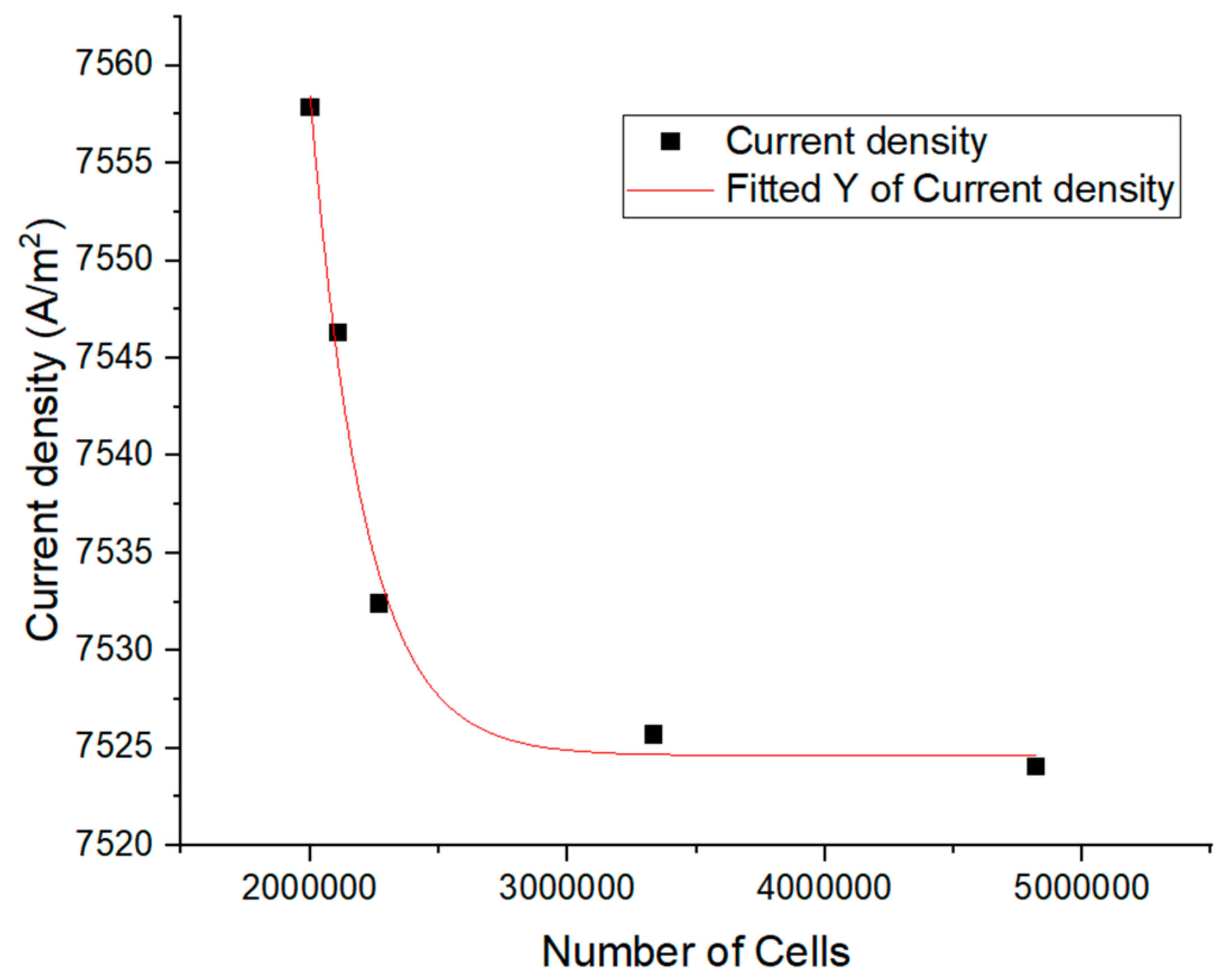


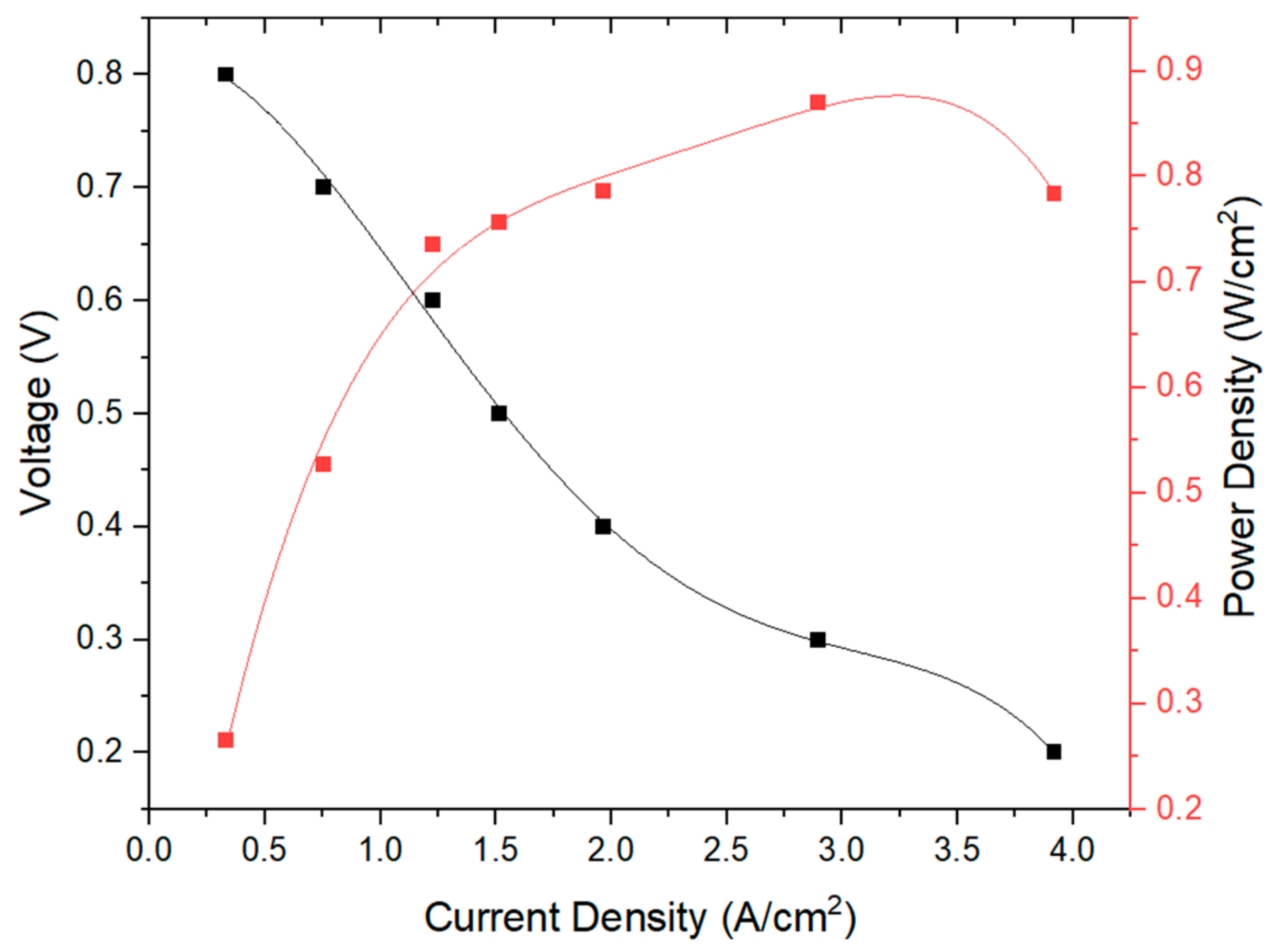
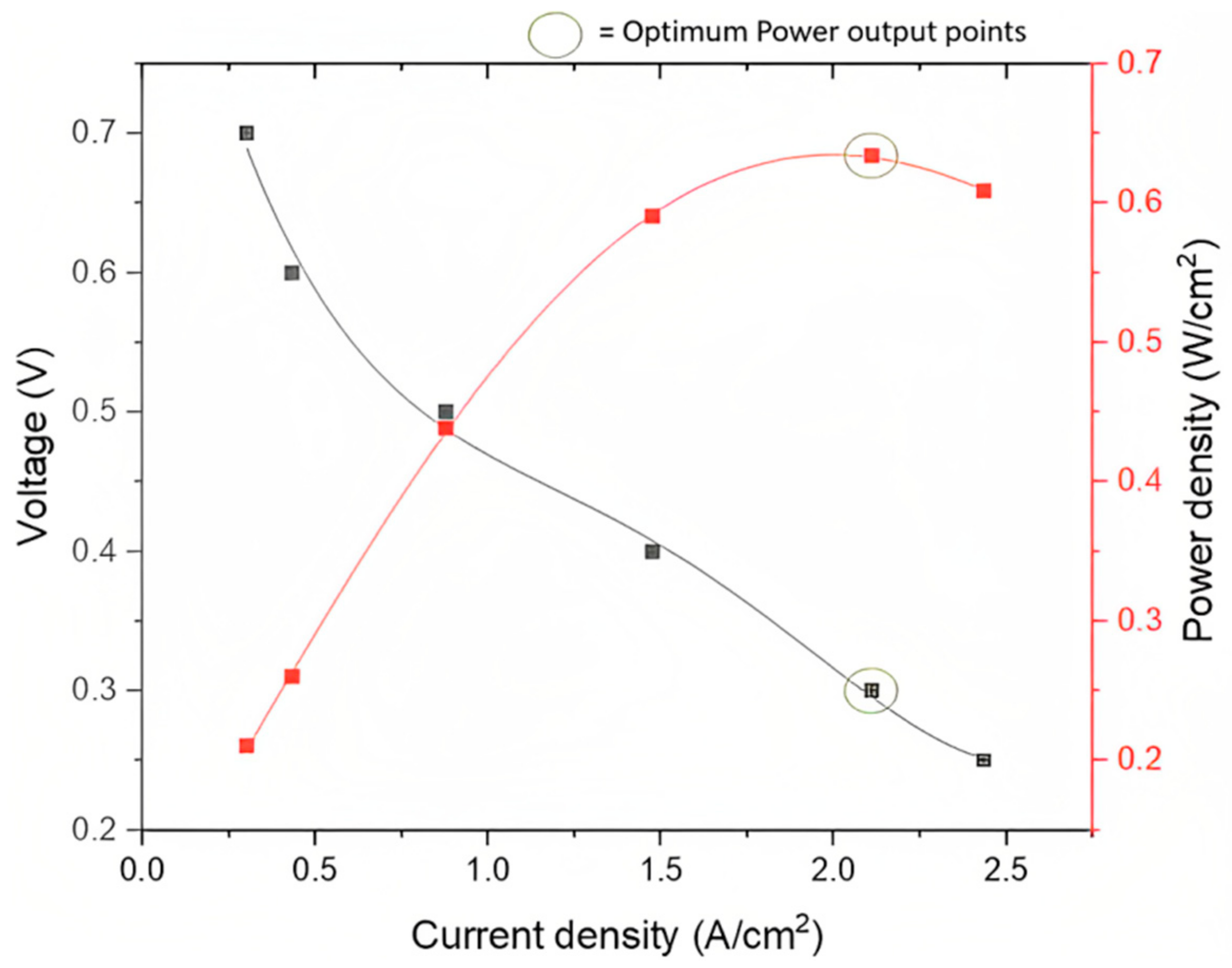
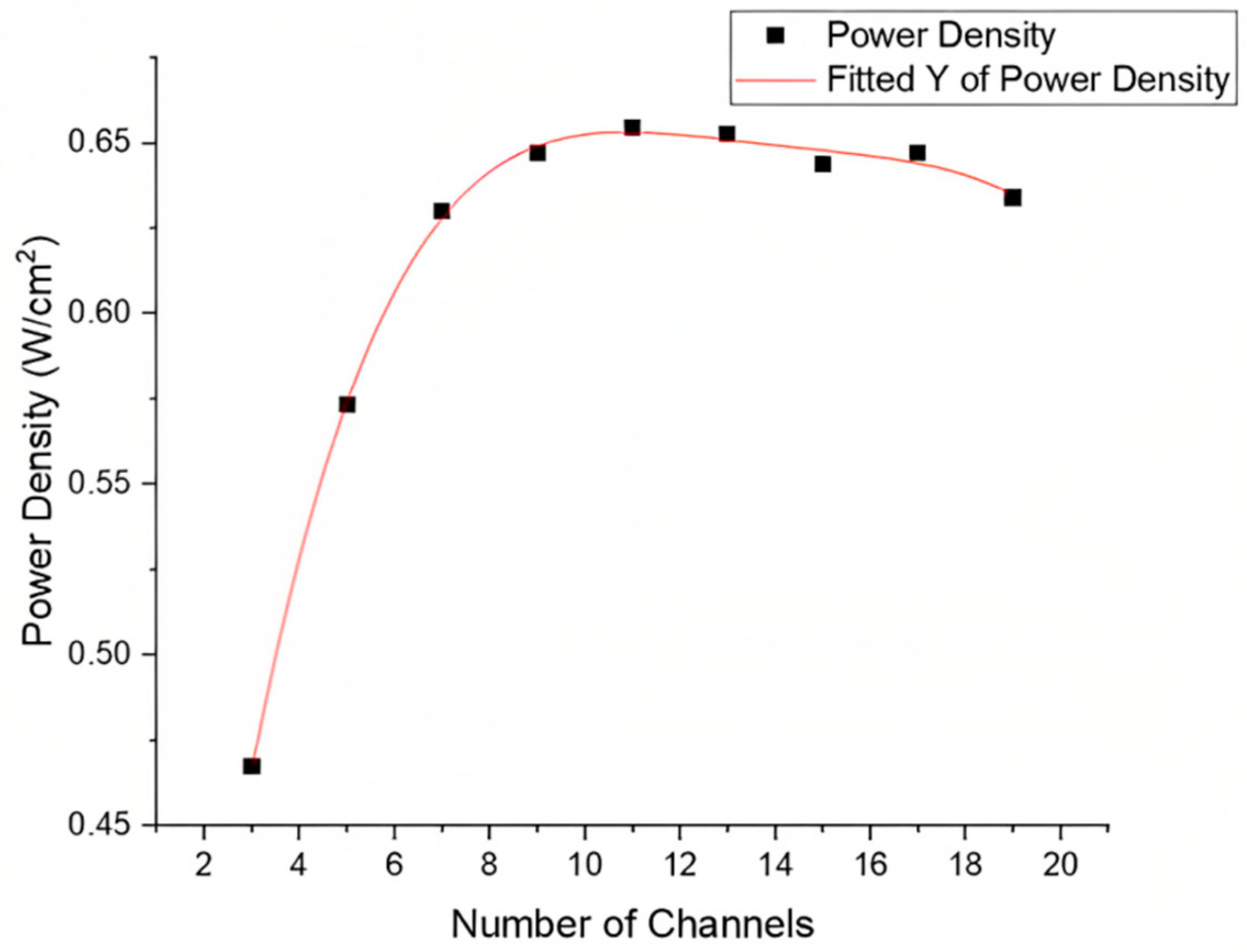
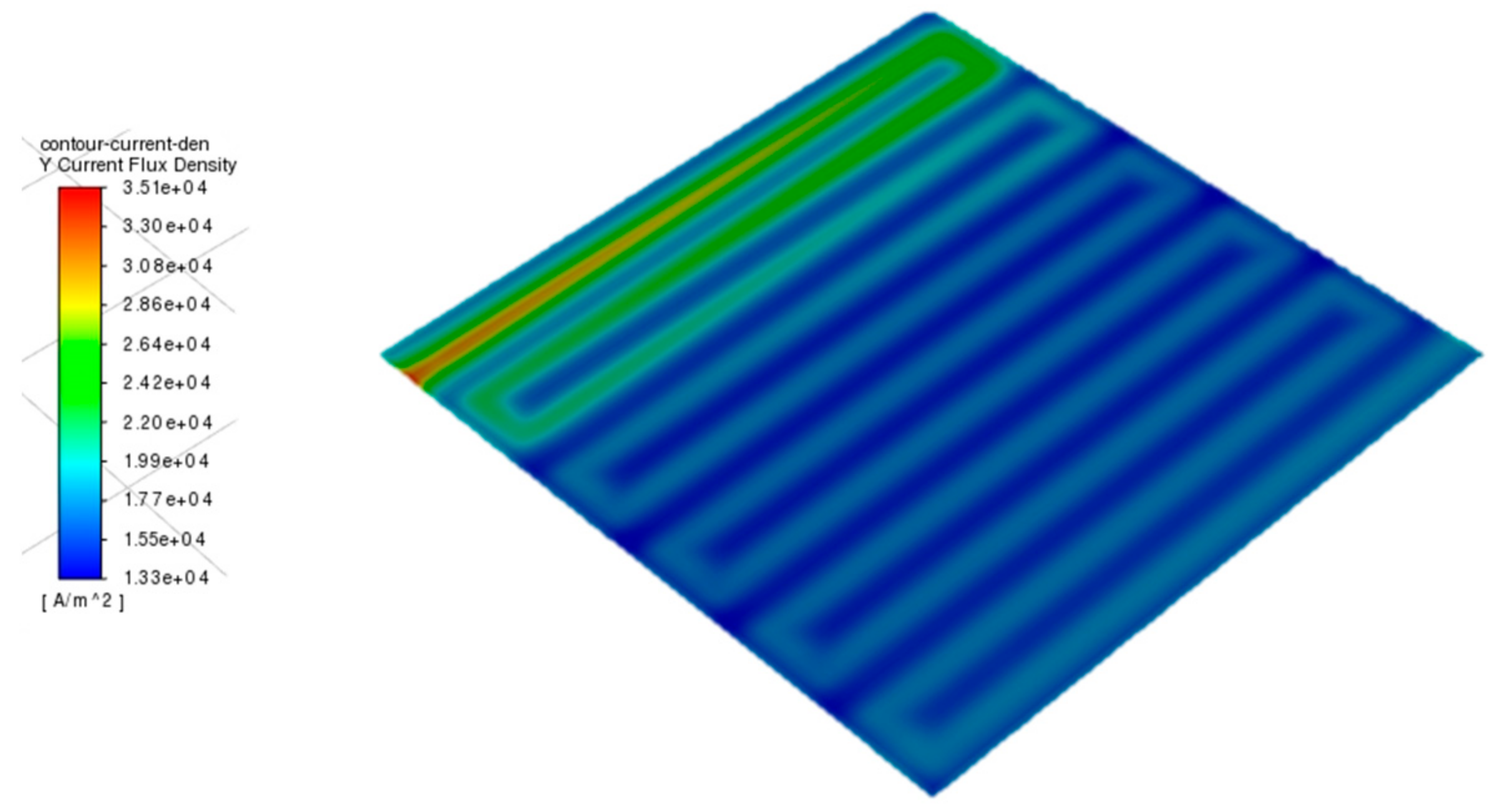
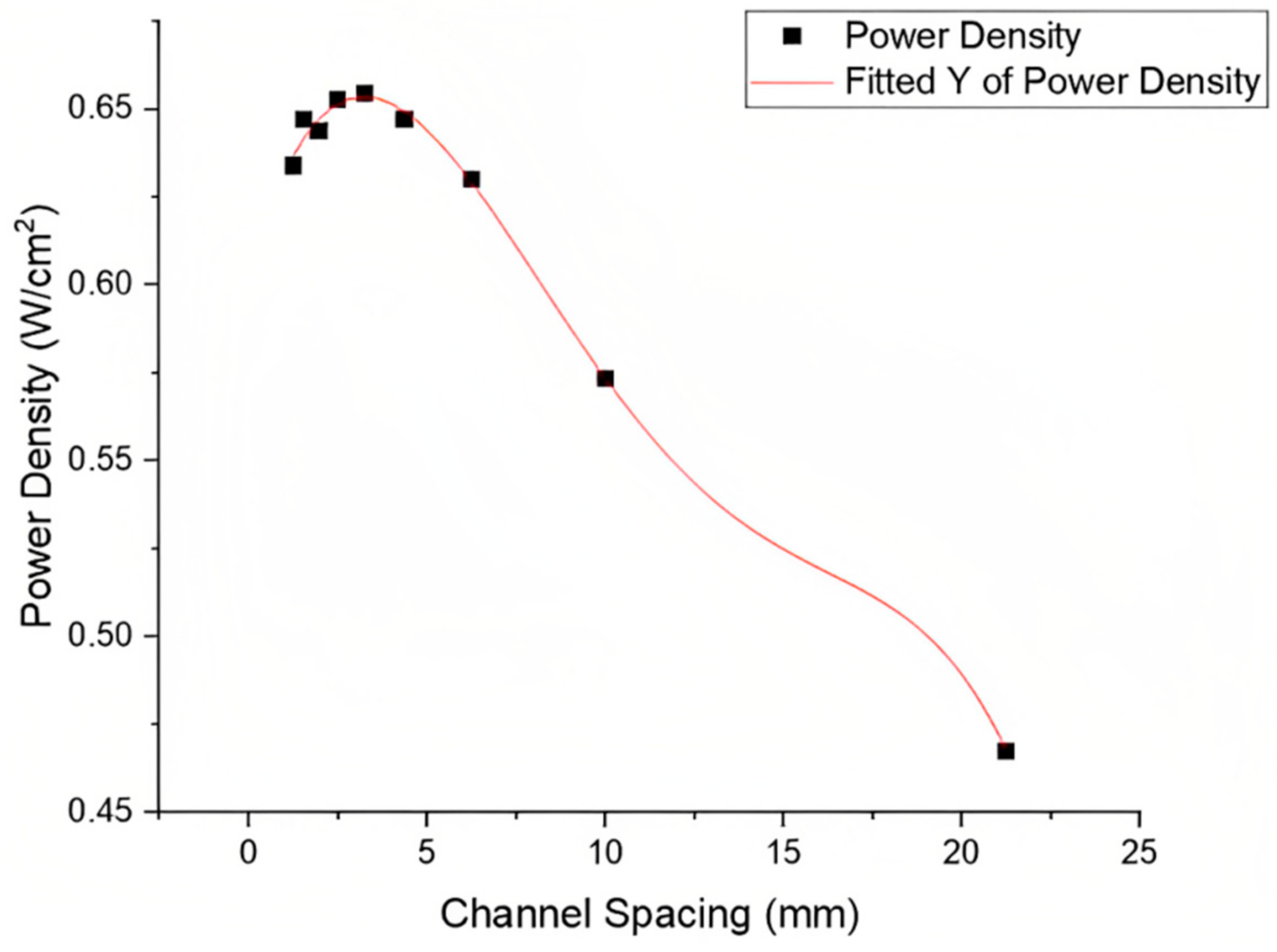


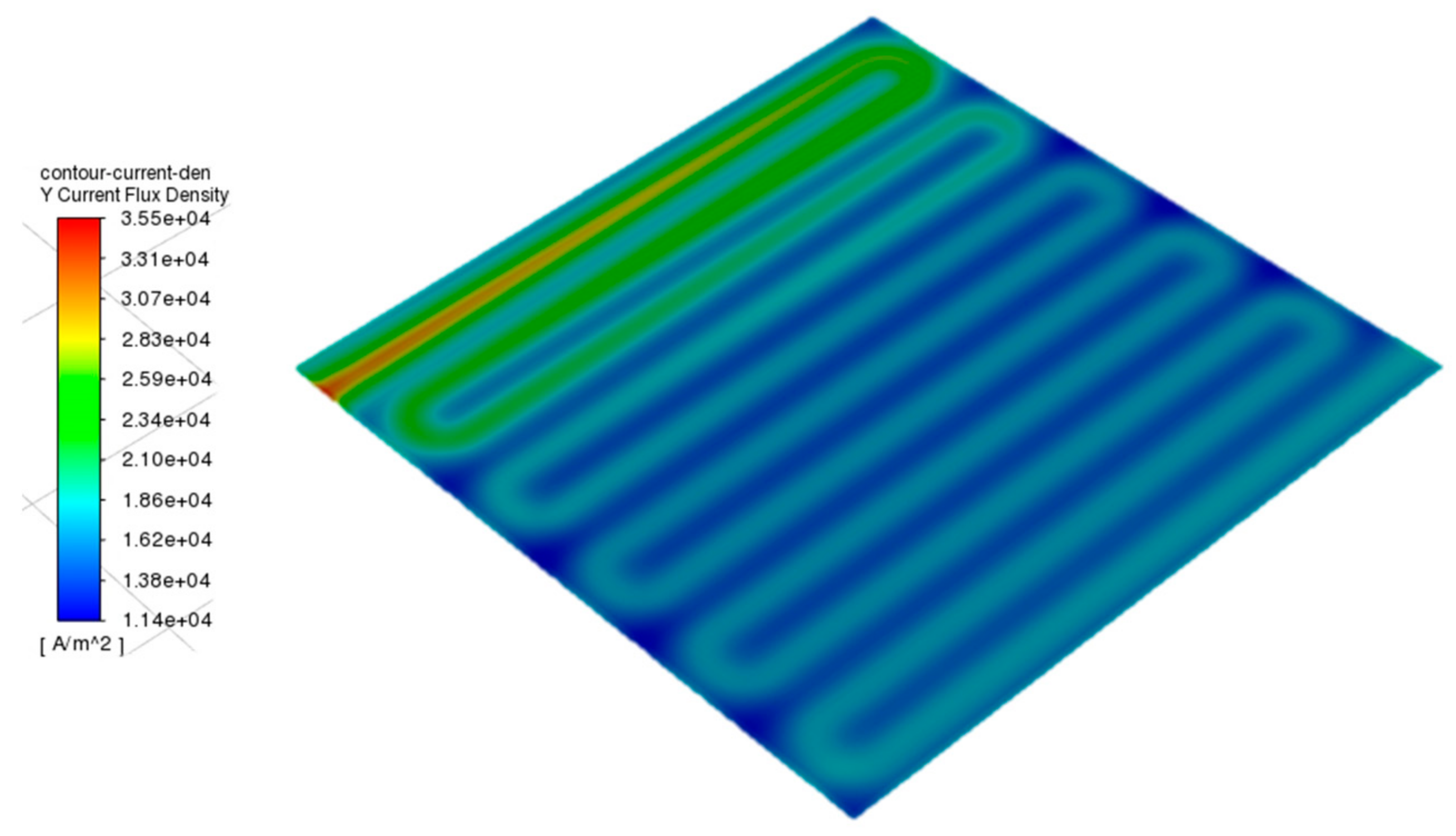
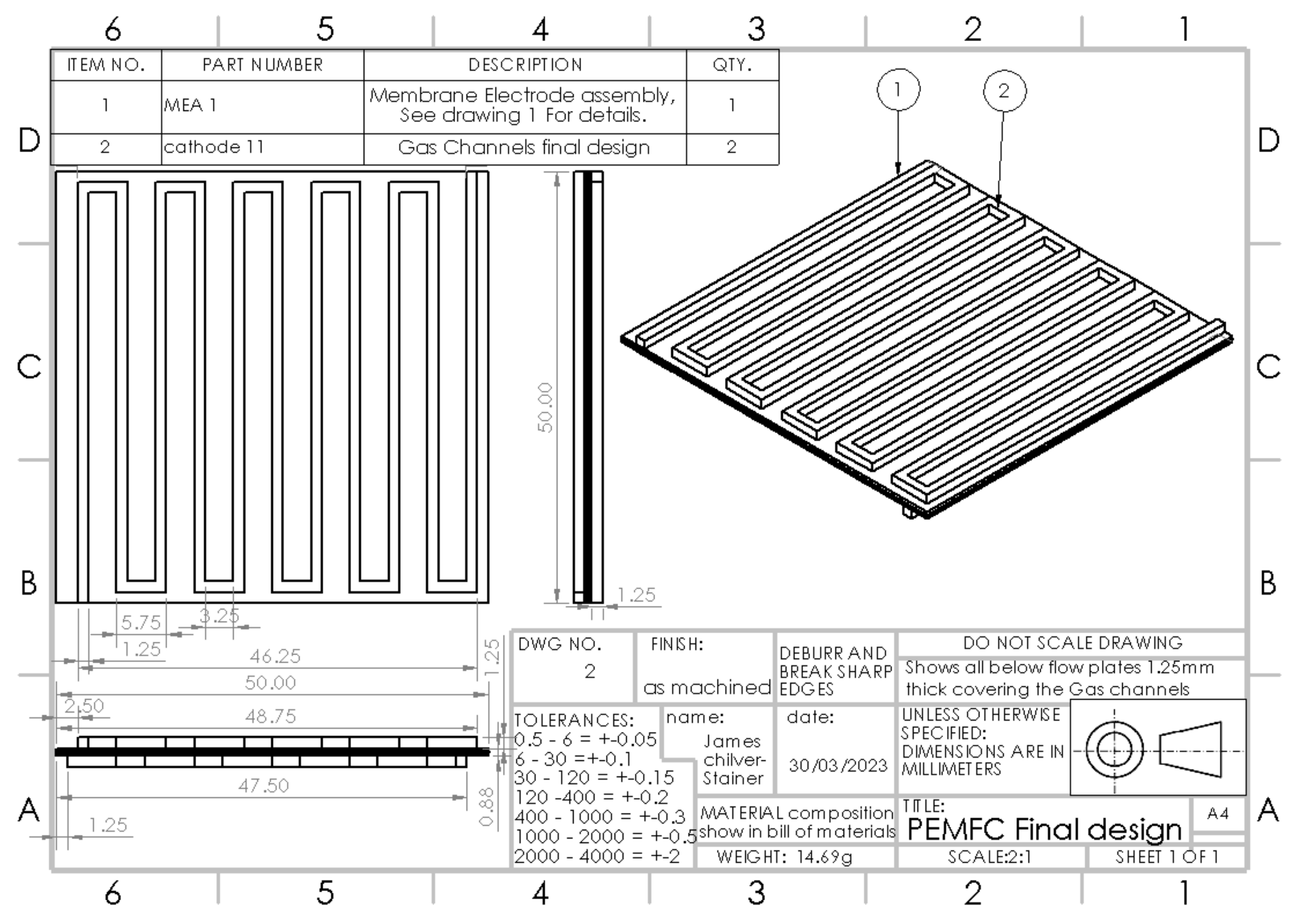
| Part | Direction | Dimension (mm) |
|---|---|---|
| Domain | [X,Y,Z] | [50,50,2.68] |
| Gas Channels | Section Width | 1.25 |
| Section Height | 1.25 | |
| Length of serpentine branches | 48 | |
| distance between serpentine branches | 1.25 | |
| GDL | [X,Y,Z] | [50,50,0.1273] |
| Membrane | [X,Y,Z] | [50,50,0.0254] |
| PEMFC Part | PEM | Flow Plate Electrodes |
|---|---|---|
| Material | Nafion | Graphite |
| Density (kg/m3) | 1970 | 2250 |
| Electrical conductivity (S/cm) | 1 × 10−16 | 125,000 |
| Thermal Conductivity (W/m K) | 0.445 | 20 |
| Specific Heat (J/kg K) | 903 | 707.68 |
| Material Represented | PEMFC Part | Density (kg/m3) | Specific Heat J/kg·K | Thermal Conductivity W/m·K | Electrical Conductivity (S/m) |
|---|---|---|---|---|---|
| graphite | flow plate | 2719 | 871 | 100 | 1,000,000 |
| GDL | 2719 | 871 | 10 | 5000 | |
| Epoxy | MPL | 2719 | 871 | 10 | 5000 |
| Platinum | catalyst | 2719 | 871 | 10 | 5000 |
| Nafion 120 | PEM | 1980 | 2000 | 2 | 1 × 10−16 |
| Material Represented | PEMFC Part | Density (kg/m3) | Specific Heat /kg·K | Thermal Conductivity W/m·K | Electrical Conductivity (S/m) |
|---|---|---|---|---|---|
| graphite | flow plate | 2250 | 707.68 | 20 | 1.25 × 107 |
| GDL | 2250 | 871 | 10 | 5000 | |
| Epoxy | MPL | 2250 | 871 | 10 | 5000 |
| Platinum | catalyst | 2250 | 871 | 10 | 5000 |
| Nafion 120 | PEM | 1970 | 903 | 0.445 | 1 × 10−16 |
| Boundary Condition Input | Value |
|---|---|
| W-diff Model | Wu |
| Liquid vapour source relaxation factor | 0.2 |
| Devised vapour/liquid relaxation factor | 0.2 |
| Osmotic drag relaxation factor | 1 |
| Gas diffusion layer liquid removal | 0.5 |
| Region | Surface | Property | Value |
|---|---|---|---|
| Anode | Inlet | Mole Fraction H2 | 0.9764 |
| Mass Flow Rate (kg/s) | 3.93 × 10−7 | ||
| Pressure (bar) | 1.5 | ||
| Temperature (K) | 300.15 | ||
| Mole Fraction H2O | 0.0236 | ||
| Outlet | Mole fraction H2, H2O | 0.9764, 0.0236 | |
| Pressure (bar) | 1.5 | ||
| Temperature (K) | 300.15 | ||
| Cathode | Inlet | Mole Fraction O2 | 0.2075 |
| Mass Flow Rate (kg/s) | 2.07 × 10−5 | ||
| Pressure (bar) | 2 | ||
| Temperature (K) | 300.15 | ||
| Mole Fraction H2O | 0.0119 | ||
| Outlet | Mole fraction O2, H2O | 0.2075, 0.0119 | |
| Pressure (bar) | 2 | ||
| Temperature (K) | 300.15 |
| Cell Size Flow Channels [mm] | Cell Size GDL [mm] | Cell Size MEA [mm] | Number of Cells |
|---|---|---|---|
| 1.5 | 0.375 | 0.75 | 2,000,968 |
| 1.25 | 0.3125 | 0.625 | 2,109,151 |
| 1 | 0.25 | 0.5 | 2,270,056 |
| 0.75 | 0.1875 | 0.375 | 3,333,827 |
| 0.6 | 0.15 | 0.3 | 4,820,839 |
| 0.625 | 0.25 | 0.5 | 2,403,259 |
| Boundary Condition | Set Value |
|---|---|
| Temperature (K) | 300.15 |
| Anode Mole Fraction H2 | 0.9764 |
| Cathode Mole Fraction O2 | 0.2075 |
| Anode Mole Fraction H2O | 0.0236 |
| Cathode Mole Fraction H2O | 0.0119 |
| Pressure (Pa) | 175,000 |
| Fillet Radius (mm) | Power Density (W/cm2) |
|---|---|
| 0 | 0.6338817 |
| 0.75 | 0.6341631 |
Disclaimer/Publisher’s Note: The statements, opinions and data contained in all publications are solely those of the individual author(s) and contributor(s) and not of MDPI and/or the editor(s). MDPI and/or the editor(s) disclaim responsibility for any injury to people or property resulting from any ideas, methods, instructions or products referred to in the content. |
© 2023 by the authors. Licensee MDPI, Basel, Switzerland. This article is an open access article distributed under the terms and conditions of the Creative Commons Attribution (CC BY) license (https://creativecommons.org/licenses/by/4.0/).
Share and Cite
Chilver-Stainer, J.; Elbarghthi, A.F.A.; Wen, C.; Tian, M. Power Output Optimisation via Arranging Gas Flow Channels for Low-Temperature Polymer Electrolyte Membrane Fuel Cell (PEMFC) for Hydrogen-Powered Vehicles. Energies 2023, 16, 3722. https://doi.org/10.3390/en16093722
Chilver-Stainer J, Elbarghthi AFA, Wen C, Tian M. Power Output Optimisation via Arranging Gas Flow Channels for Low-Temperature Polymer Electrolyte Membrane Fuel Cell (PEMFC) for Hydrogen-Powered Vehicles. Energies. 2023; 16(9):3722. https://doi.org/10.3390/en16093722
Chicago/Turabian StyleChilver-Stainer, James, Anas F. A. Elbarghthi, Chuang Wen, and Mi Tian. 2023. "Power Output Optimisation via Arranging Gas Flow Channels for Low-Temperature Polymer Electrolyte Membrane Fuel Cell (PEMFC) for Hydrogen-Powered Vehicles" Energies 16, no. 9: 3722. https://doi.org/10.3390/en16093722





